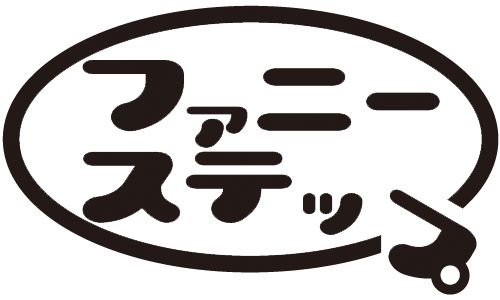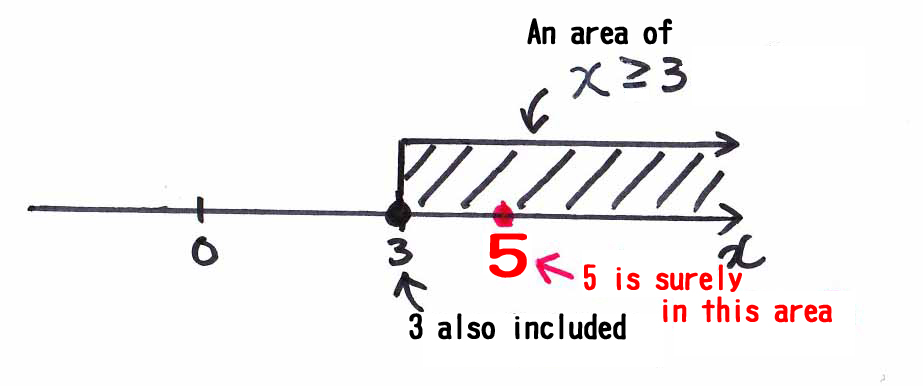 > Start from deep points TOP> 7. What means
> Start from deep points TOP> 7. What means  ,
,  ?
?

7. What means  ,
,  ?
?
THAT IS,
Addition of a equal sign (=) and a inequal sign (<, >).
At first,
let's think when we use equal signs?
We use it as
(left-hand side) = (right-hand side).
This means that
a value of (left-hand side) is completely the same with a value of (right-hand side).
Then, what means inequal signs (<, >)?
When we express
(left-hand side) < (right-hand side),
a value of (left-hand side) is smaller than a value of (right-hand side).
If we used as 3<5, it is a correct formula.
And, when we say x>3,
x is not 3, but x represents all numbers which is bigger than 3.
If we sorts numbers in order of its size,
they are linked continually to far (that is, infinite).
A number in the center of every two numbers (we can select any two as our wills)
must exist.
However small distance of two numbers we select,
there are numbers between them and we can find them.
So, we, human beings, can not say concretely what number it is
as a number which is nearest 3 and is bigger than 3.
(That reason is:
Whatever number we say, other numbers exist between that said number and 3.
Then our said number is not the nearest number of 3.)
But we can distinguish that all our said numbers (which are bigger than 3 or smaller than 3) are not 3.
(So we can sort all numbers except for 3
into which side of a point 3 on a number line as number groups, smaller or bigger than 3. (I changed expressions from "small or big".)
And we can show a number nearer and nearer to 3 by the upper process.)
We can say the upper discussion using by a number line,
we express a right area of a point 3
as all numbers which is bigger than 3.
(If we drew a fat line on that area,
we can show places of numbers which are bigger than 3)
So, we can draw it as below figure.

Then, what means an inequal sign with an equal sign?
For example, what means x 3?
3?
It means "3 and over" area, as we usually say.
That is, x is a number which is 3 or bigger than 3.(*)
(x can not change two numbers at once.)
x=3 and x>3 do not share a common part of a number line.
I will show that in a number line.



I will show (*) in formulas.
When x 3,
3,
x has two cases, "x is 3." or "x is bigger than 3."
then
"x=3" or "x>3".
And more,
3=5 is not correct
and 3<5 is a correct formula.
Then,
is 3 5 a correct expression or not?
5 a correct expression or not?
I think you have not used such expression.
(You can see this answer under more than 1 page scrolled.)
As I say a conclusion,
the answer is "right".
3 5 is a correct expression.
5 is a correct expression.
Formulas also represent some concepts and thoughts like sentences with words.
So formulas can also inform some concepts and thoughts.
In this case, if we read that formula in English,
"5 is 3 or more than 3."
It seems correct, because we use "or".
If we draw that on a number line,

5 enters an area of numbers which is 3 or are bigger than 3.
So, it show clearly a correct concept.
(It is important for our correct thinking to clarify any discussions till this degree.)
But we usually do not write as such.
We write 3<5.
Why we do so?
When we solve math problems or in our tests,
"if a more correct answer exists, that is a better conclusion."
So, we recommend an answer without =, and we call that is a correct answer.
That is,
It is important whether we think all about any problems.
(I want to say here "all topics" means all we can think at that time.)
In this example case,
we did not check about whether 3 is equal 5 or not.
So we did not think all and did not completed our thinking.
3 5 is not the last and best conclusion.
5 is not the last and best conclusion.
So in tests, we will get a wrong mark or lose partial score.
2017.10.06 I changed "small and big" to "smaller and bigger than 3."



 > Start from deep points TOP> 7. What means
> Start from deep points TOP> 7. What means 





